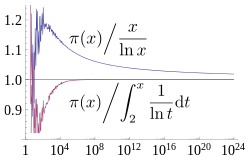Fil:Prime number theorem ratio convergence.svg

Storleken för denna PNG-förhandsvisning av denna SVG-fil: 250 × 160 pixlar. Andra upplösningar: 320 × 205 pixlar | 640 × 410 pixlar | 1 024 × 655 pixlar | 1 280 × 819 pixlar | 2 560 × 1 638 pixlar.
Originalfil (SVG-fil, standardstorlek: 250 × 160 pixlar, filstorlek: 87 kbyte)
Filhistorik
Klicka på ett datum/klockslag för att se filen som den såg ut då.
| Datum/Tid | Miniatyrbild | Dimensioner | Användare | Kommentar | |
|---|---|---|---|---|---|
| nuvarande | 21 mars 2013 kl. 15.07 |  | 250 × 160 (87 kbyte) | Dcoetzee | Change n to x to match article |
| 21 mars 2013 kl. 14.30 |  | 250 × 160 (86 kbyte) | Dcoetzee | Convert formula from graphics to pure SVG using http://www.tlhiv.org/ltxpreview/ | |
| 21 mars 2013 kl. 14.23 |  | 250 × 160 (130 kbyte) | Dcoetzee | {{Information |Description ={{en|1=A plot showing how two estimates described by the prime number theorem, <math>\frac{n}{\ln n}</math> and <math>\int_2^n \frac{1}{\ln t} \mathrm{d}t = Li(n) = li(n) - li(2)</math> converge asymptotically towards <ma... |
Filanvändning
Följande sida använder den här filen:
Global filanvändning
Följande andra wikier använder denna fil:
- Användande på ar.wikipedia.org
- Användande på bn.wikipedia.org
- Användande på ca.wikipedia.org
- Användande på el.wikipedia.org
- Användande på en.wikipedia.org
- Användande på fa.wikipedia.org
- Användande på he.wikipedia.org
- Användande på hu.wikipedia.org
- Användande på hy.wikipedia.org
- Användande på id.wikipedia.org
- Användande på ja.wikipedia.org
- Användande på no.wikipedia.org
- Användande på pl.wikipedia.org
- Användande på sl.wikipedia.org
- Användande på sr.wikipedia.org
- Användande på ta.wikipedia.org
- Användande på vi.wikipedia.org



